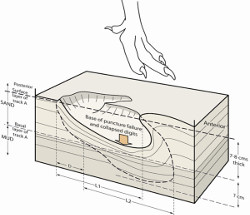Vertebrate Track Modelling
The tracks of both extant and extinct vertebrates potentially offer unique sources of information, providing insight to past environments, gait, posture, locomotion and behaviour. The Manchester approach applies both physical soils testing and the computational modelling of tracks to provide an understanding of the formation, preservation and interpretation of vertebrate tracks.
Tracks can potentially offer unique sources of information, providing insight into the environments, gait and posture, locomotion and behaviour. Track preservation can yield important information on substrate consistency and enable the recognition of transmitted subsurface tracks. The ability to recognize transmitted tracks has broad implications for the understanding of palaeoenvironments and interpretation of ichnological assemblages. In order to gain an understanding of how tracks are formed in three dimensions, and of their variability of expression in different substrates, controlled laboratory simulations were undertaken. Experiments were designed to recover subsurface track layers, yielding for the first time detailed information on subsurface morphology that could be related to 'true' surface track features. It was found that subsurface track relief can be correlated with the magnitude and distribution (across a foot) of load acting on the surface sediment. This pressure is transmitted through the sediment, and deforms successive layers at depth, producing an undertrack. The most significant factor controlling track morphology, whether surface or subsurface, was found to be the moisture/density relationship within the substrate at the time of track formation. Variability in the dimensions of simulated tracks, relative to the 'true' surface track, indicates that caution should be exercised when using fossil tracks to calculate hip height, speed, age, and population dynamics. In addition, comparison of experimental tracks with dinosaur tracks from the Yorkshire coast suggests that many morphological differences between vertebrate ichnotaxa reflect sediment rheology and taphonomy rather than taxonomy of the track-maker.

Palaeontologists recognise that they have a tough challenge when faced with determining how dinosaurs went about their day to day activities, for example how fast they could run and whether bipedal examples walked with the upright gait typical of museum displays. Apart from the occasional pile of petrified bones, the only other clues available are track-ways or fossilised footprints. Even these are contentious, with disagreement as to whether track morphology can be used to identify different species. As well as the morphology of the footprint itself, in the three-dimensional zone beneath, sedimentary deformations provide a snapshot of how the ancient sediment responded to loading. The nature of these plastic deformations depends on many factors - sediment composition, humidity and how the loading was applied. In soil mechanics, there are many plasticity models that could be applied to help back-figure the prevailing conditions and thus how the dinosaur walked. In essence, a footprint simulation would be no different from one carried out for a foundation design. However, there are many features that would make it perhaps more computationally demanding: Firstly the loading will have been applied obliquely and secondly the fine scale structure of the soil needs to be adequately represented. Both these factors mean that the problem is irreducibly three-dimensional. Capturing the level of detail required to compare field, laboratory and computational studies, means that plasticity problems with tens of millions of degrees of freedom must be solved.
Well-established techniques in computational geomechanics are potentially of significant use to the palaeontology community. Numerical analysis using the finite element method and constitutive models for soils can be used to better understand the processes involved. However, this type of study can be quite time consuming. The soil behaviour can only be truly represented using three dimensions. The soil that the dinosaur stepped upon has since turned to rock and a parametric study for a range of soil properties is required to give meaningful results. Reducing solution times to enable detailed scientific studies to be carried out requires parallel computation.
Lead researchers
- Prof. Phil Manning
- Prof. William Sellers
- Dr. Lee Margetts
- Dr. Emma Finch
- Dr. Karl Bates


